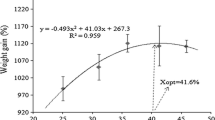Abstract
This study investigated the influence of different dietary protein/carbohydrate ratios on activities of enzymes involved in the amino acid metabolism as well as on growth performance and body composition of Nile tilapia (Oreo- chromis niloticus). Fish were fed semi-synthetic diets differing in their protein/carbohydrate ratio. The diets were formulated to be isolipidic and isoenergetic (on the basis of metabolizable energy). Fish were reared individually. After a prefeeding phase, tilapia were randomly assigned to three groups and were fed the experimental diets at a relatively low level. The study lasted 9 weeks. Proximate composition, gross energy content, and activities of aspartate aminotransferase (ASAT) and alanine aminotransferase (ALAT) in the liver of fish were determined. While the mean growth rate and feed conversion efficiency did not differ significantly among the feeding groups, the body composition showed significant differences. The dietary protein/carbohydrate ratio had no significant effect on the protein and energy gain, but the lipid gain was significantly higher in tilapia fed the low-protein diet. The activities of ASAT and ALAT per gram of liver and per gram of soluble protein were significantly increased in fish fed the high-protein diet. There was a significant positive correlation between the activities of ASAT and ALAT. The activities of both enzymes in the liver were significantly higher in fish with a higher protein gain. Measuring the activities of enzymes involved in the amino acid metabolism can provide more information about the metabolic utilized dietary protein.
Similar content being viewed by others
References
Ahmad MH, Abdel-Tawwab M, Khattab YAE (2004) Effect of dietary protein levels on growth performance and protein utilization in Nile tilapia (Oreochromis niloticus L.) with different initial body weights. In: Boliver RB, Mair GC, Fitzsimmons K (eds) Proceedings of 6th International Symposium on Tilapia in aquaculture. Philippine International Convention Center, Roxas Boulevard, Manila, Philippines, pp 249–263
Brett JR, Groves DD (1979) Physiological energetics. In: Hoar WS, Randall DJ, Brett JR (eds) Fish physiology. Academic Press, New York, pp 280–325
Cho SH, Lee SM, Lee SM, Lee JH (2005) Effect of dietary protein and lipid levels on growth and body composition of juvenile turbot (Scophthalmus maximus L.) reared under optimum salinity and temperature conditions. Aquacult Nutr 11:235–240
Cowey CB, Walton MJ (1989) Intermediary metabolism. In: Halver JE (ed) Fish nutrition. Academic Press, San Diego, pp 260–321
Dabrowski K, Murai T, Becker K (1986) Physiological and nutritional aspects of intensive feeding of carp. In:␣Billard R, Marcel J (eds) Aquaculture of cyprinids. INRA, Paris, pp 55–70
Dean JC, Garling DL, Nielsen LA (1986) Effects of dietary protein quantity and protein quality on growth rate and on selected enzyme activities in channel catfish. Comp Biochem Physiol B 83:355–363
FAO (2005) Fishstat plus database (Fishstat Plus), December 2005, FAO, Rome, Italy (http://www.fao.org)
Fournier V, Huelvan C, Desbruyeres E (2004) Incorporation of a mixture of plant feedstuffs as substitute for fish meal in diets of juvenile turbot (Psetta maxima). Aquaculture 236:451–465
Gaye-Siessegger J, Focken U, Abel H, Becker K (2004) Individual protein balance strongly influences δ15N and δ13C values in Nile tilapia, Oreochromis niloticus. Naturwissenschaften 91:90–93
Kim KI, Grimshaw TW, Kayes TB, Amundson CH (1992) Effect of fasting or feeding diets containing different levels of protein or amino acids on the activities of the liver amino acid-degrading enzymes and amino acid oxidation in rainbow trout (Oncorhynchus mykiss). Aquaculture 107:89–105
Lupiáñez JA, Sánchez-Lozano MJ, García-Rejón L, De la Higuera M (1989) Long-term effect of a high-protein/non-carbohydrate diet on the primary liver and kidney metabolism in rainbow trout (Salmo gairdneri). Aquaculture 79:91–101
Metón I, Mediavilla D, Caseras A, Cantó E, Fernández F, Baanante IV (1999) Effect of diet composition and ration size on key enzyme activities of glycolysis- gluconeogenesis, the pentose phosphate pathway and amino acid metabolism in liver of gilthead sea bream (Sparus aurata). Br J Nutr 82:223–232
National Research Council (1993) Nutrient requirements of fish. National Academy Press, Washington, p 114
Naumann K, Bassler R (1983) Handbuch der landwirtschaftlichen Versuchs- und Untersuchungsmethodik. III. Die chemische Untersuchung von Futtermitteln. Neumann-Neudamm, Melsungen
Pieper A, Pfeffer E (1980) Studies on the comparative efficiency of utilization of gross energy from some carbohydrates, proteins and fats by rainbow trout (Salmo gairdneri R.). Aquaculture 20:323–332
Richter H, Lückstädt C, Focken U, Becker K (2003) Evacuation of pelleted feed and the suitability of titanium(IV) oxide as a feed marker for gut kinetics in Nile tilapia. J Fish Biol 63:1080–1099
Schlechtriem C, Focken U, Becker K (2003) Effect of different lipid extraction methods on δ13C of lipid and lipid-free fractions of fish and different fish feeds. Isotopes Environ Health Stud 39:135–140
Steffens W (1985) Grundlagen der Fischernährung. VEB Gustav Fischer, Jena, p 226
Stryer L (1990) Biochemie. Spektrum der Wissenschaft, Heidelberg, p 1127
Wood CM (1993) Ammonia and urea metabolism and excretion. In: Evans DH (ed) The physiology of fishes. CRC Press, Florida, pp 379–426
Acknowledgements
This study was partly funded by a DFG grant to J. Gaye-Siessegger (GA 1068/2-1). The authors wish to thank B. Fischer for her support in the laboratory.
Author information
Authors and Affiliations
Corresponding author
Rights and permissions
About this article
Cite this article
Gaye-Siessegger, J., Focken, U. & Becker, K. Effect of dietary protein/carbohydrate ratio on activities of hepatic enzymes involved in the amino acid metabolism of Nile tilapia, Oreochromis niloticus (L.). Fish Physiol Biochem 32, 275–282 (2006). https://doi.org/10.1007/s10695-006-9000-1
Received:
Accepted:
Published:
Issue Date:
DOI: https://doi.org/10.1007/s10695-006-9000-1




